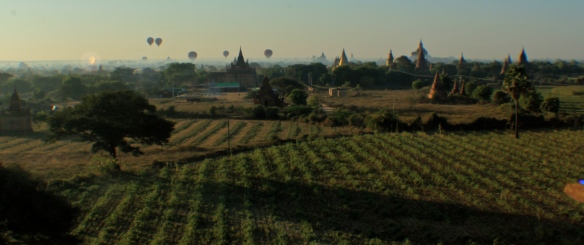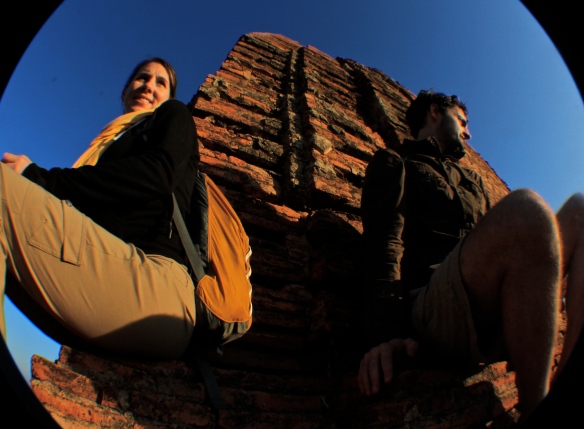
After surviving our first of several long bus rides in Myanmar, during the wee hours of the morning—homeless, stinky, cold, and mildly disorientated—we had arrived in Bagan. We settled into a hostel that can only be described as a small upgrade from a basic jail cell, but it did its job. Adding some festive cheer by hanging up some Christmas stockings that David had brought over from Taiwan fittingly on the towel rack, it became our home for the next couple of nights. 
We felt so home-y that a bearcut happened.
Once the capital of the Pagan Empire, during Bagan’s glory days, over 10,000 Buddhist temples, monasteries, and pagodas were built, scattered throughout the arid plains east of the Irrawaddy River, like chocolate chips on the perfect twenty six square mile cookie. Bad analogy… I might be craving something.
Today, over 2,000 of those remain.
For the next couple of days, we set off on our bicycles and went on a nonstop marathon of all things Buddhist, going and stopping wherever we pleased. The flat, dusty roads were ours.
On one occasion we spotted a small dead snake on the side of the road and naturally being the nutty one that I am, I picked it up with a stick, attracting the attention of a local. He seemed sincerely concerned for all of about five seconds. He warned us that the snake was a deadly cobra and demanded that I throw it away immediately and then insisted we take a look at some of his art. Oh, creative businessmen.
Aside from the postcard hustlers–some cute, some obnoxiously insistent, who seemingly appeared out of nowhere–we had the pagodas mostly to ourselves. The boy on the far right, in the orange shirt, whose brief conversational English was flawless, also appears at the end of this video that I found by Visualtraveling.
We entered each pagoda barefooted, our toes and fingers gripping the chipped red claywork, climbing through narrow passages like monkey detectives, to take in the views. Despite it being peak tourist season, Bagan was pretty quiet and for those moments, it felt like the valleys and plains were entirely ours. It was amazing.
For archaeologists and historians, the area of Bagan is one holy breadbasket of historical evidence and treasures turned preservationist nightmare, an “unmitigated disaster” to some. Over 400-recorded earthquakes shook the area between 1904 and 1975, destroying thousands of the empire’s remains. When the government attempted to repair those damages for the sake of reviving the tourism industry, their lack of architectural integrity and utilization of “inauthentic building materials” ended up desecrating the historical and religious merits that Bagan once represented. As a direct result of this, Bagan has until now been unable to attain UNESCO World Heritage recognition. 
One late afternoon we hopped on a small boat to cross the Irrawaddy to do a quick hike to visit a monastery where the views were said to be quite lovely, overseeing the entire plain scattered with grand reminders of the once powerful region.
Cooking fires may have ruined those views but it was still a nice hike. Daniel and I finagled with manual settings on our cameras, and the sunset wasn’t too bad either.












